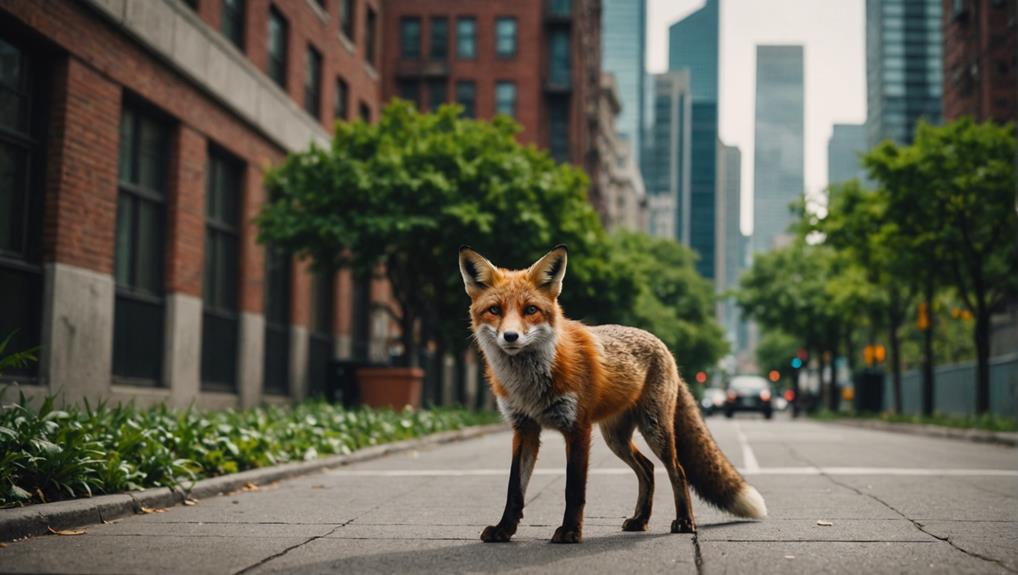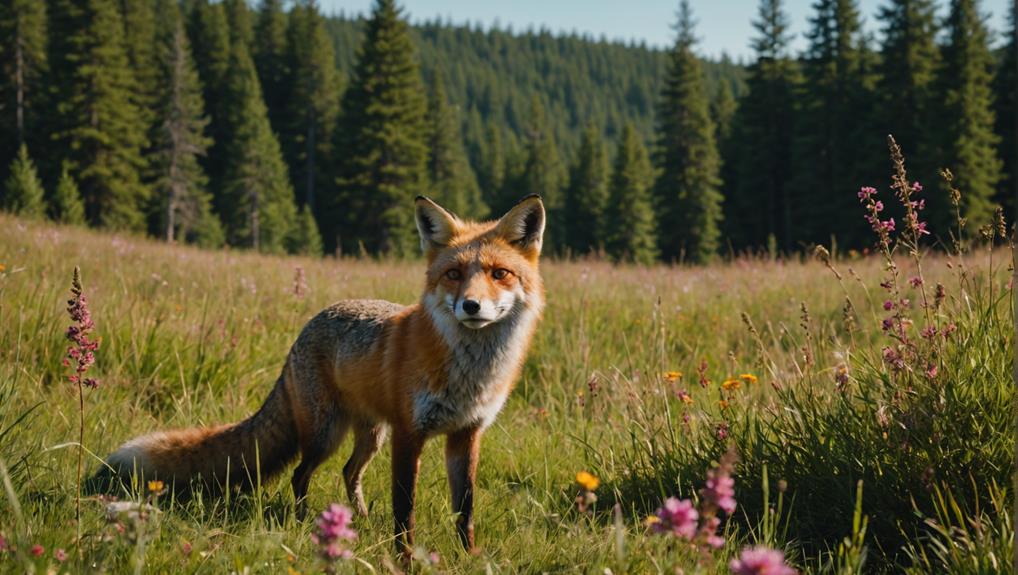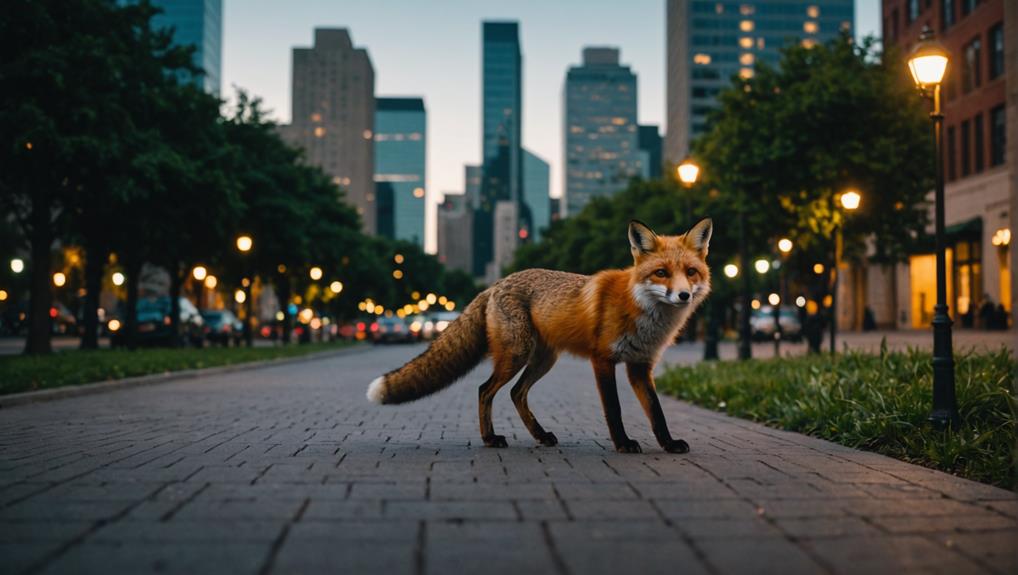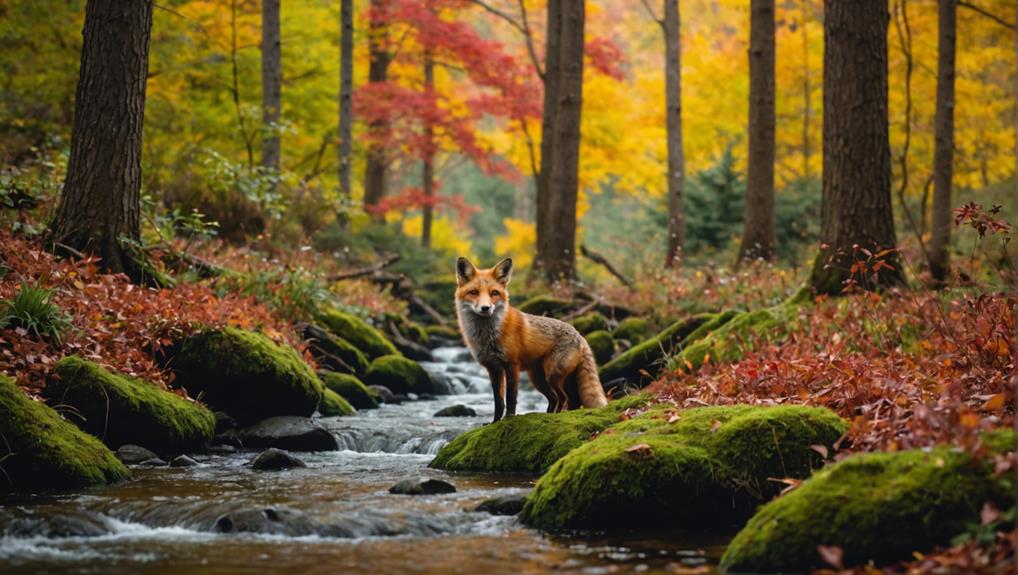Red foxes are truly amazing animals, thriving in a variety of habitats! You'll find them in forests, grasslands, deserts, and even around urban areas—yes, those sneaky little furballs can adapt to city life. They love mixed landscapes like woodlands and farmland, where food is abundant. Spring's a busy time as they build dens, while winter sees them foraging in dense cover. Surprisingly, middle-class suburbs often become their cozy homes. So, whether they're chasing rodents in the grass or scavenging leftovers, they're always resourceful. Stick around, and you'll uncover even more intriguing facts about these clever creatures!
Contents
- 1 Red Fox Range: A Global Overview
- 2 Adaptation and Survival in Diverse Ecosystems
- 3 Urbanization and the Adaptability of Red Foxes
- 4 Conservation Efforts and the Red Fox
- 5 Recognizing Red Fox Habitats
- 6 Tips for Wildlife Enthusiasts
- 7 Habitat Suitability for Red Foxes
- 8 Ecological Interactions and Prey Dynamics
- 9 Urban Fox Populations Worldwide
- 10 Understanding Red Fox Behavior
- 11 Final Thoughts
Red Fox Range: A Global Overview
Red foxes occupy an impressive range of nearly 70 million km² across the Northern Hemisphere, including North America, Europe, and Asia, with populations even established in Australia. Isn't that fascinating? Their distribution showcases remarkable adaptability, as they thrive in diverse habitats like forests, grasslands, deserts, and yes, even urban areas!
You might be surprised to learn that red foxes have found a cozy niche in cities, often seen frolicking in parks and gardens.
When it comes to habitat selection, these clever critters really know how to make the most of their surroundings. They can be spotted in woodlands, rural neighborhoods, wetlands, and brushy fields. This flexibility means you might encounter a red fox right outside your window!
The geographical diversity of red foxes is also intriguing. Take specific subspecies, like V. v. montana in the Rocky Mountains or V. v. niloticus in parts of Africa. Each one is uniquely adapted to its environment.
Adaptation and Survival in Diverse Ecosystems
When you think about red foxes, imagine them darting through bustling city streets or sneaking around your backyard.
These clever critters adapt to various habitats, whether they're hunting for dinner in urban parks or cozying up in dense woodlands.
As seasons change, their survival skills kick in, showing just how resourceful they can be in finding food and mates, even when the competition gets tough!
Urban Habitat Preferences
Urban environments have become an unexpected haven for foxes, with recent studies showing a remarkable increase in their populations in cities.
You might be surprised to learn that these clever red foxes thrive in middle-class suburbs, where private gardens offer less disturbed nesting spots. They've even been spotted raising cubs in some rather unusual places, like Yankee Stadium!
These adaptable animals have developed a knack for living among humans.
Here's how they do it:
- Nesting Opportunities: Private gardens provide safe spots for dens, away from the hustle and bustle.
- Food Sources: Urban foxes are savvy scavengers, capitalizing on the plentiful food options that cities provide.
- Movement: They can easily transition between urban and rural habitats, making them incredibly versatile.
As you can see, red foxes are truly remarkable creatures.
Their ability to thrive in urban settings shows just how resilient they can be.
Seasonal Adaptation Strategies
Seasonal adaptation strategies play a crucial role in how red foxes navigate their diverse ecosystems.
These clever creatures switch up their habitat use based on the seasons. For instance, during winter, they expand their foraging to include areas with dense cover, making it easier to hunt small mammals that are less active in the cold. You might say they've got a knack for finding the best hide-and-seek spots!
When prey is plentiful, red foxes cache food, stashing away tasty morsels for those leaner times. This smart move helps them store energy and resources, especially during winter when food can be scarce.
And let's not forget about their denning behavior! As spring approaches, female foxes get busy constructing new dens, often in safe, cozy spots, preparing to welcome their little ones.
What's truly impressive is their adaptability. Red foxes thrive in a range of environments—from bustling urban areas to serene rural landscapes.
Their ability to shift and adjust to seasonal changes shows just how resilient these furry friends can be. So, next time you spot a red fox, remember the impressive strategies it employs to survive and flourish!
Competition and Resource Availability
Red foxes are resourceful survivors, skillfully navigating competition in their habitats.
These clever creatures face challenges from other predators like coyotes and tawny owls, which can impact their access to prey. But don't worry; red foxes adapt brilliantly to their surroundings!
Here are a few ways they manage competition and resource availability:
- Opportunistic Feeding: Red foxes switch between different prey like rodents and rabbits, depending on what's available.
- Urban Adaptation: In urban areas, where natural food sources might be scarce, they've become adept at scavenging from garbage and even hunting pets.
- Expanding Territories: The growth of agricultural lands has created new habitats, giving red foxes more opportunities to thrive.
Their ability to shift their hunting strategies based on competition means they can still find enough food, no matter the environment.
So, whether they're weaving through a bustling city or prowling a peaceful countryside, red foxes are always on the lookout for their next meal.
It's a tough world out there, but these clever critters make it work!
Urbanization and the Adaptability of Red Foxes

You might be surprised to learn that red foxes are thriving in urban environments, even more so than in the countryside!
These clever critters have a knack for finding food and cozy spots to raise their young amidst our busy cities, from parks to private gardens.
Urban Habitat Preferences
Urban environments have become surprisingly welcoming habitats for red foxes, showcasing their remarkable adaptability.
These clever canids have shown they can thrive in urban habitats, often exhibiting higher population densities in cities than in rural areas. You might find them darting through private gardens, parks, or even your own backyard!
Here are a few things that make urban life a hit for red foxes:
- Private Spaces: Suburban environments with gardens and less disturbance offer safe spots for raising cubs.
- Flexible Movement: They easily navigate between urban and rural areas, searching for food and mates.
- Global Presence: Studies show significant populations in 114 cities worldwide, with many in the UK, Europe, North America, and Australia.
Red foxes have a knack for adapting to human modifications in their habitats. This resilience allows them to coexist with us, often surprising city dwellers with their playful antics.
Food Source Adaptability
The adaptability of red foxes extends dramatically to their food sources, showcasing their opportunistic feeding habits. You'll find these clever creatures thrive in urban environments, where they've learned to make the most of what's around them. In cities, they don't just feast on small mammals and birds; they also scavenge for delicious scraps in garbage cans or leftover farm produce. It's like a buffet for them!
Interestingly, studies reveal that red foxes often have higher population densities in urban areas than in rural ones. They cleverly exploit gardens and parks for food, especially when winter rolls in and wildlife becomes scarce. During this time, they shift their focus to human-related food sources, showcasing their incredible adaptability for survival.
Another fascinating behavior is their caching. This means they store surplus food, which comes in handy during lean seasons.
And let's not forget, the presence of game species like rabbits and pheasants in agricultural areas has only helped fox survival rates.
Conservation Efforts and the Red Fox
Conservation efforts for red foxes are crucial in maintaining their stable population, especially in areas where they face localized threats. While red foxes are classified as Least Concern by the IUCN Red List, habitat loss and invasive species still pose challenges.
You can help keep these clever critters thriving through various initiatives:
- Support habitat protection: Encourage local policies that preserve their living spaces.
- Raise public awareness: Share information about red foxes and their ecological role.
- Get involved: Participate in community events or donate to wildlife organizations.
Ongoing projects focus on managing the impact of red foxes, particularly in places like Australia, where they're an invasive species wreaking havoc on native wildlife.
It's important to remember that while red foxes adapt well to human environments, they still need our help to mitigate threats.
By learning more and taking action, you can be part of the solution. Together, we can ensure that these charming animals continue to roam our landscapes, bringing joy and beauty to our natural world.
Recognizing Red Fox Habitats

When you think about red fox habitats, picture a mix of cozy woods, sprawling farms, and even your local park.
These clever critters can thrive in both urban and rural settings, making them quite the adaptable little survivors.
As you explore different landscapes, keep an eye out for signs of their presence—after all, you never know when a furry friend might be just around the corner!
Preferred Habitat Types
How do red foxes thrive in such diverse habitats? These clever creatures have a knack for adapting to various environments, making them quite the survivors.
You'll find red foxes in mixed landscapes, from scrublands to woodlands and farmland. They especially love mosaic forests, where young conifer plantations offer food and shelter, while mature forests provide cozy resting spots.
When it comes to urban environments, red foxes have become quite the opportunistic feeders. They scavenge in gardens, parks, and streets, making cities a surprisingly suitable home.
Seasonal changes also play a big role in their habitat preferences. As food availability shifts, so do these crafty foxes, ensuring they always find a meal.
Here's a quick look at their preferred habitats:
- Mosaic forests: Great for food and shelter.
- Urban environments: Increasingly popular due to accessible resources.
- Farmlands: Offer abundant prey like rodents and rabbits.
Red foxes are versatile and resourceful, adjusting to their surroundings with ease. With their clever nature, they remind us that thriving in diverse habitats is all about being adaptable and making the most of what's available!
Urban Vs. Rural Areas
While red foxes are often associated with rural landscapes, you might be surprised to find that they thrive just as well in urban areas. These clever critters are incredibly adaptable, often making their homes in gardens, parks, and even bustling streets. Believe it or not, they can raise their cubs in places as iconic as New York City's Yankee Stadium!
In rural habitats, red foxes typically roam agricultural lands and woodlands, searching for food. However, in urban settings, they prefer suburban areas with private gardens that offer more peace and less disturbance. This flexibility is part of what makes red foxes so fascinating. Tracking studies show that they can easily move between urban and rural habitats, showcasing their resourcefulness and knack for finding food.
Recent data highlights that urban fox populations are growing across Britain, proving they can colonize both urban and rural environments successfully.
Tips for Wildlife Enthusiasts
Spotting red foxes in their natural habitat can be an exhilarating experience for wildlife enthusiasts. These clever creatures thrive in mixed landscapes, often near urban areas where food is easily accessible.
To increase your chances of a sighting, consider these tips:
- Timing is Key: Early morning or dusk are prime times to observe these nocturnal foxes. They're most active during these hours, so set your alarm or grab a snack for a twilight adventure!
- Look for Signs: Keep an eye out for tracks, scat, and scent markings on trees or rocks. These clues can lead you to where foxes roam, making you feel like a wildlife detective!
- Join the Community: Engaging in local wildlife observation events or guided tours can enhance your experience. You'll learn more about foxes' behaviors and habitats while ensuring you don't disturb their natural environment.
Using apps or websites that track wildlife sightings can also help you find areas with known red fox populations.
Habitat Suitability for Red Foxes

Red foxes are incredibly adaptable creatures, thriving in a variety of habitats that provide essential resources for their survival. You might be surprised to learn that these clever critters have a strong habitat preference, leaning towards mosaic forests with young conifer plantations, which offer both food and shelter.
They also love mature forests where they can take a cozy nap after a long day of foraging.
Interestingly, red foxes show seasonal variability in their habitat choices. During breeding seasons or when food availability shifts, they adjust their habitats accordingly, ensuring they've what they need to thrive.
While you may think flat open country or sparse woodlands could be suitable, these areas are actually less ideal. Red foxes prefer habitats like scrubwood, meadows, and pine forests, as seen in studies from Tuscany.
Urban adaptation has also been a game-changer for red foxes. They often thrive in cities, where higher population densities can be found compared to rural areas.
Ecological Interactions and Prey Dynamics
In the intricate web of their ecosystems, red foxes play a crucial role in shaping prey dynamics and ecological interactions.
These clever canines help maintain ecological balance by regulating the populations of their prey. But how do they do it? Let's break it down:
- They compete with other carnivores for food resources, impacting prey density across various habitats.
- Their prey dynamics shift with the seasons, often moving from coastal areas to woodlands as food availability changes.
- The introduction of game species like rabbits and pheasants boosts their survival and population growth.
By keeping prey populations in check, red foxes ensure that no single species dominates an area, which helps maintain a healthy ecosystem.
This competition also drives adaptability, as foxes learn to navigate their habitats effectively.
You might say they're the skilled chefs of the animal kingdom, constantly adjusting their menus based on what's fresh and available.
Urban Fox Populations Worldwide

Across the globe, urban environments have become thriving habitats for red foxes, showcasing their remarkable adaptability. These clever canids have made a name for themselves, proving they can flourish in city environments. In fact, urban fox populations are so robust that you'll find significant groups in 114 cities worldwide, from the bustling streets of London to parks in North America and even Australia!
Isn't it fascinating? In the UK alone, about 56 cities are home to these charming critters, while many more can be found across mainland Europe. They've even been spotted raising their cubs in the heart of the city, like at Yankee Stadium—talk about a wild suburban life!
Red foxes easily navigate between urban and rural areas, revealing their flexibility when it comes to finding food and potential mates. The expansion of agricultural land has encouraged their presence in mixed landscapes filled with gardens and parks.
Understanding Red Fox Behavior
Foxes living in urban areas showcase not just their adaptability to new environments, but also their unique behaviors that help them thrive. You might be surprised to learn how red foxes manage to navigate city life effortlessly.
Their solitary hunting behavior means they often hunt alone, primarily targeting small rodents, birds, and rabbits. But they're also opportunistic feeders, meaning they'll scavenge and cache food for later use if necessary.
Here are a few fascinating traits of red foxes to consider:
- They communicate using a diverse vocal repertoire, with around 12 distinct sounds. You could say they've quite the chatty personality!
- Scent marking with urine helps them establish territory. It's like their version of putting up a "No Trespassing" sign.
- Their adaptability allows them to thrive in various habitats, whether in rural or urban settings.
These clever creatures not only adapt quickly to new challenges but also manage their surroundings with impressive skill.
Final Thoughts
So, whether they're darting through the woods or sneaking around urban backyards, red foxes are truly fascinating creatures. Their ability to adapt to different habitats, from forests to cities, shows just how clever they are. By understanding their homes and behaviors, we can appreciate these sly little critters even more. So next time you spot one, remember: you're witnessing nature's own little survivor, making the best of whatever environment it calls home!














